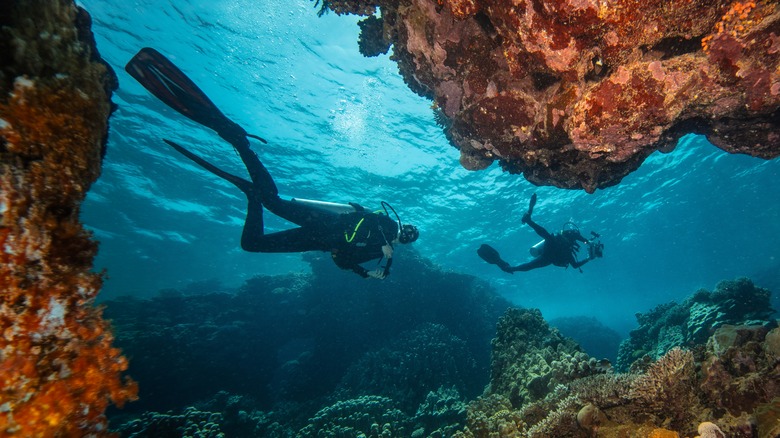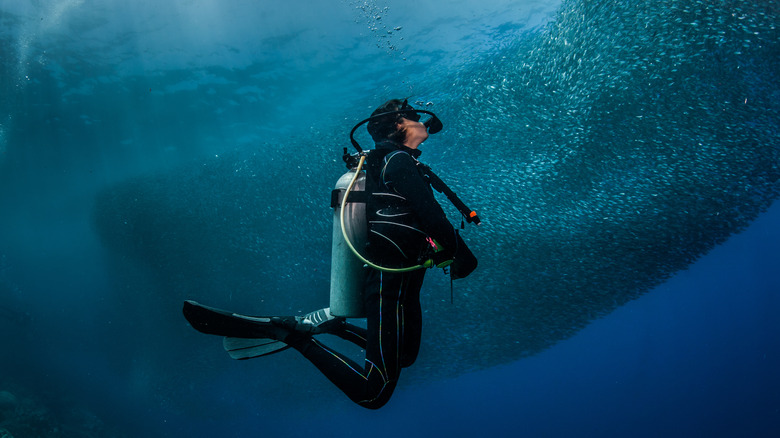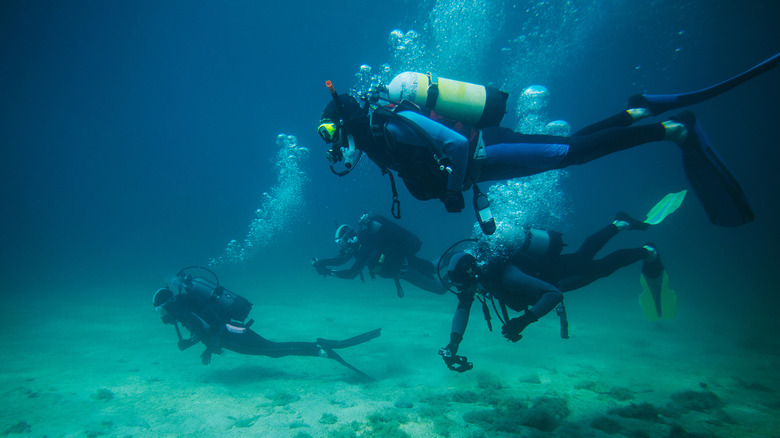Safety Tips To Know Before Your Scuba Diving Adventure
We may receive a commission on purchases made from links.
While most extreme sports remain somewhat outside the mainstream of outdoor activities, scuba diving has been rapidly growing in popularity in recent years. Much of this has to do with the rise in last chance tourism, as many of the world's natural wonders are also found underwater. Like all extreme sports, there are inherent risks involved with scuba diving. According to the Divers Alert Network, or D.A.N., there are thousands of scuba-related injuries, which result in well over 100 deaths annually.
Despite those eye-popping numbers, it is entirely possible to safely enjoy underwater adventures. Like all extreme sports, safe scuba diving is a result combination of proper training and following safety procedures. Equipment maintenance also plays a key role, as scuba divers rely on several pieces of specialized equipment that must function properly. Beyond maintenance, to ensure it is fully functional and won't glitch out on you at a critical time, diving equipment is among the outdoor gear you should never buy used.
Within those three basic categories, there are a myriad of ways to improve safety while exploring underwater. For example, there are a number of dangerous ocean creatures that inhabit many popular dive spots. Safe diving protocol calls for passive interaction with all ocean creatures. This means keeping your hands tucked close to your body, not harassing the animals, and observing from a respectful distance. However, being safe around marine life is just one step in the right direction to have a safe diving experience. There are several other safety tips to know before you embark on scuba diving.
Plan your dive and know what to do in an emergency
Much of a safe scuba diving adventure has to do with preparation before you actually get in the water. Because diving is stressful and taxing on the body in a variety of ways, staying in shape is a must, as poor physical fitness has been linked to an exceedingly high number of dive accidents. You should consider your level of physical conditioning when planning your dive. How fit you are — or are not — can impact decisions such as how deep to dive, conditions you are able to dive in, and the amount of time you can remain underwater.
It is also a good idea to be familiar with the dive site, as well as your equipment. As part of the planning process, you should check your equipment to ensure it's in good working order. The plan should also include making sure to have emergency life-saving equipment handy and have an emergency action plan. Everyone involved in the dive should be familiar with both the dive plan and emergency action plan.
As an individual diver, you should also be informed as to how to handle various situations, such as you or your dive buddy unexpectedly running out of air, being accidentally left by a dive boat, or becoming lost at sea while scuba diving. Part of that preparation means furthering your diving education by becoming certified, as well as being equipped with gear such as an emergency air pony bottle and a safety sausage for alerting others to your location.
Master buoyancy control and be S.A.F.E.
Like any sport, becoming proficient in the skills necessary for safe scuba diving requires lots of practice and experience. However, you don't have to wait for a diving excursion to hone these skills. In fact, you shouldn't. You should get in as much practice as you can in a swimming pool before heading on a scuba diving adventure.
One of the more important skills you need to master is controlling your buoyancy underwater. Part of this is knowing how much weight to use. As a rule of thumb, when geared up, you should float at eye level with your buoyancy compensator (BC) empty and holding your breath. When you exhale this breath, you should slowly sink. Once under water, you will rely on the amount of air in your BC to maintain proper buoyancy as the pressure increases the deeper you go. Be sure to make small adjustments to the air in your BC and allow time for those adjustments to take effect. It is important not to overcompensate by adding or releasing too much air at one time.
Given that many dive-related injuries happen while returning to the surface, arterial gas embolism and decompression sickness being two major ones, it is important to be S.A.F.E. While that may just sound like basic advice, it is actually an acronym that is to be a reminder to Slowly Ascend From Every dive. A controlled ascent is necessary from any depth and deeper dives require a decompression time at a 15-foot depth before reaching the surface. It is important to take this into account when planning your dive so you ensure you have a sufficient air supply.


